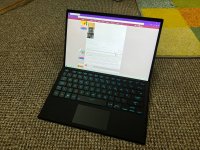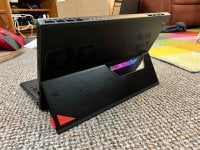Last year’s tech is still good - a cheaper look at the ROG Flow Z13
Last year I was wanting a new portable powerhouse and I had my eyes set on two in particular, both from ASUS’ latest gaming releases of the time. These were the Zephyrus Duo 16, and the Flow Z13. Both were, and frankly still are, really cool devices that stand out from the crowd. On one hand we have a gaming laptop equipped with two screens and some powerhouse-level specs, and on the other we have a slightly more toned down tablet that outperforms anything of its form factor. While they were both interesting, I settled on the Duo at the time with its power and dual screen layout swinging me. A thought lingered though: I wish the Z13 were cheaper. If it were cheaper, I could probably find a way to justify buying it… If it were cheaper…
The ROG boxes always feel wonderfully gamey, I can't help but be charmed by them.
So now it’s cheaper. When the Z13 launched back in January of last year you had two variations at two price points. At the top end, which we actually covered on the site, you have a model featuring a 4K 16:10 display, coming in at £3000. On the lower end, you’re looking at a 1200p 16:10 display, itself coming in at £1900. Outside of the screen differences, you have the same 12th generation i9-12900H and 3050 Ti under the hood, supported by 2x 8 GB sticks of LPDDR5 RAM and a 1 TB M2 SSD. You have the same tablet form factor, the same Surface-like but slightly flashier detachable keyboard, the same IO and battery. To just get this out of the way, I think the 4K model was terrible value when it launched, and while it is discounted now as I’m about to go into, there’s just not enough there to justify the higher price point. You don’t need a 4K display on a 13 inch screen. All you’ll be doing is draining your battery quicker for a quality difference you aren’t going to notice.
Another year, another CES, and another announcement from ASUS for the 2023 model of the Z13, we’re now seeing the price cuts that come just before the dawn of a new generation. The 4K model drops to £2000 which is nice, but what should really be catching your eye is that the 1200p model is now £1200. And it’s at this price we start to see a tablet that might actually have a chance of competing. With many thanks to my usual lack of self-control and a weak justification behind the decision, I decided to pick one up. I haven’t regretted it.


I'm quite fond of the glowing transparent window, it's a unique embellishment that really isn't garish or particularly over the top.
The Flow Z13 is ultimately a heavier Surface with worse battery life, but what you gain for that heft and faster battery drain is a discrete GPU in the 3050 Ti, and a solid i9 CPU. It’s a powerhouse for its form factor, even if it might be lacking if compared to an actual gaming laptop for the same price. The reason I wanted to pick this up is for the versatility of the tablet form factor. I can take it with me without needing to carry a huge bag, or I can just have it on my desk with the keyboard detached to have a video watching display while I’m working on my primary setup. The 3050 Ti inside might not sound like much, but it’s enough to eke out 60fps on games like Hitman 3 and Elden Ring, admittedly on low settings.
At £1200 it stands at a genuinely competitive price point when compared to the latest Surface Pro. For roughly the same money, you’d be looking at a 12th generation i5 with 8 GB of RAM and a 256 GB SSD. There’s obviously more to it than a straight up spec for spec comparison, but at this price it basically becomes another tier of Surface instead of some standalone device that’s priced into obscurity.
Make no mistake, this device isn’t perfect. When I mentioned the worse battery life earlier, I really did mean it. You’re looking at four to five hours of use when fully charged, and that isn’t gaming use. The Surface Pro 9’s battery is similar in capacity, but will last you up to three times that. The weight can also make it more difficult to use as a tablet if you’re sitting on the sofa or in bed. These are reasonable considerations for what you personally need your tablet to do. For me, I’m used to heavy devices and I’m rarely away from a plug for more than a few hours.
This looks weird, but I promise it works well.
While I’ve been making plentiful comparisons to the Surface Pro, the Z13 does have a trick up its sleeve: XG Mobile compatibility, though you’d be forgiven for not knowing exactly what that is. Featuring its own proprietary port that is made up of a Thunderbolt 4 component, and a unique part that looks a bit like a thin DisplayPort, the XG Mobile connection is designed as an external graphics interface to surpass what is possible with your more traditional Thunderbolt eGPUs. It’s an all in one package really. You have external graphics, four USB Type-A ports, a DisplayPort, a HDMI port, and finally a 2.5G Gigabit Ethernet port to round it out. This is all in a lightweight package you could easily fit into a bag. What makes the XG Mobile connection interesting is how ASUS claim it completely eliminates any performance bottlenecks you might have come to expect from external graphics, as well as adding dedicated bandwidth for the aforementioned IO. You can think of it like switching from the built-in laptop 3050 Ti to another internal GPU. But this is where the problems might begin.
To get the XG Mobile into such a lightweight form factor, ASUS have opted for a mobile GPU. In reality, it means that while you are trading up in terms of power, you are still being limited to what a gaming laptop with a laptop 3080 inside would already be able to do. That’s not the worst thing in my mind, with it being a somewhat valid trade off when you compare it to full-sized eGPUs like Razer’s Core X Chroma. One I can fit in a bag pocket, one I’d need to bring a small suitcase for. If I’m being honest, I’m really fond of the XG Mobile I have here, and I like that it’s basically a souped-up docking station that transforms an incredibly portable tablet into an incredibly portable and versatile powerhouse. I really like how easy it is to use, and I find how it works really interesting too. When you plug it in, you’ll get a pop-up asking if you want to activate it. Once done, it’ll disable your internal laptop 3050 Ti and in its place, you’ll see the laptop 3080 appear. It’s really fluid, and with this all being in-house ASUS tech, I came across no random driver incompatibilities. I didn’t even need to install new drivers with both the XG Mobile and my internal graphics both being Nvidia. Without enabling the eGPU the USB ports do still appear to work, so I’d wager the Thunderbolt part of this connection is what’s being used for your IO, with the fancy connector being where the graphics magic happens.
Being able to detach the keyboard means I really can just throw this anywhere I want and generally it works wonders.
It really is an interesting device that gives you a noticeable boost when playing games. With thanks to ASUS for lending me a unit for a little while, I went from being able to play Elden Ring on low settings at 60 FPS (which is still impressive in my mind for a tablet) to being able to play on max settings with no issues. It’s so seamless and I do think a large part of that is because it’s proprietary software working together. But that’s just it; it’s all proprietary. And that’s why I don’t think I could ever recommend getting one. You have a genuinely great device, but it’s one you can neither upgrade nor use with anything else. You can’t even buy it standalone, and the only way to get it with the Z13 is to buy it with the 4K model, which in itself doesn’t present great value as I mentioned earlier. In my mind, the best middle ground would’ve been to have the XG Mobile port on both the tablet and the external graphics, and support standard Thunderbolt connections with all the bottlenecks that come with it. At least that way you’re left with some flexibility and support should ASUS decide to drop this port like Alienware did before them with their own proprietary graphics solution. It’s good, but it’s not worth heading out to eBay and spending what is basically the price of the tablet again for. I want ASUS to take this device further, but to do so it needs to be more available and more flexible.
Having bought the Flow Z13 last month, I’ve had a blast with it. I can’t say how happy I am to see the device at a more reasonable price, but with the new 2023 model just around the corner, should you be waiting for that instead? It’s a challenging question because it does seem ASUS are wanting to push this tablet form factor to its absolute limits, giving the GPU a fairly substantial upgrade to the laptop flavour of Nvidia’s 4060. I don’t have a laptop with this on hand, but the stats online are looking really promising. With this extra power under the hood, as well as a generational bump to the i9 processor, I can imagine the battery being even worse. This is all just speculation at this point though.
Taking the previous image a step further, you can see here my Zwift setup, with the biking app going on the tablet display, and a game or video taking the monitor.
Even with the additional power coming soon, I think I still prefer the 2022 model at £1200; it does everything I need it to and has been a great travel companion for working away. If the Flow Z13 isn’t for you, I would at least take from this story that, as the title might suggest, last year’s tech is still good. There are some great deals out there to be found if you’re not always chasing the latest and greatest, and I’d really encourage you to look. I’m somewhere in the middle myself, falling to the temptations of a good deal and shiny new thing alike, as I’ve somewhat shown in grabbing the Zephyrus Duo 16 at launch and the Flow Z13 a year later.
Are you the type of person to get new tech out of the gate, or do you prefer to wait for a great deal? Let us know below.






